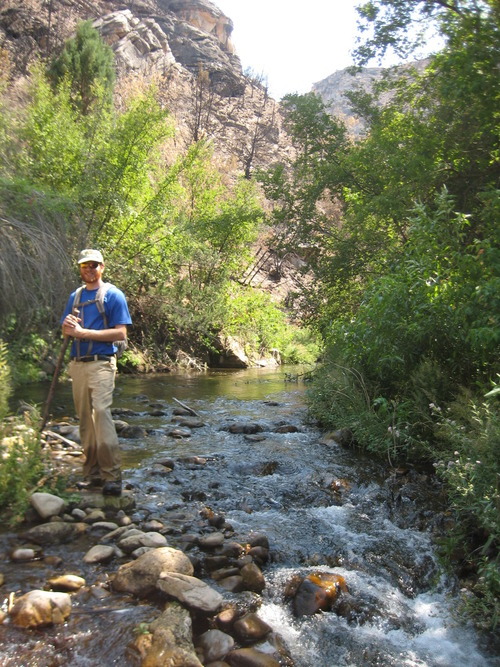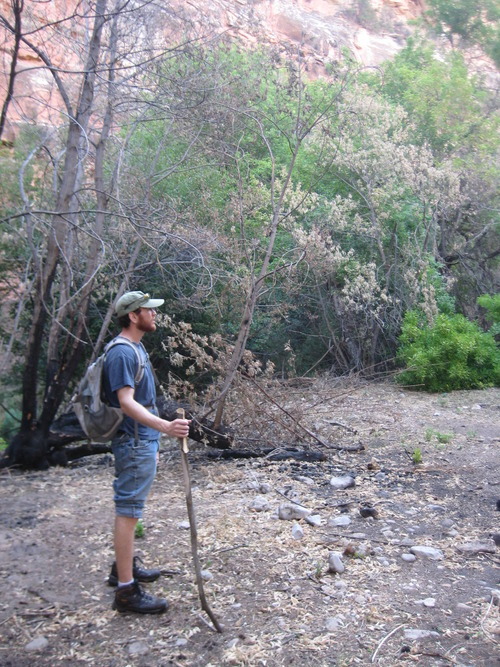Besides the fact that I live at the base of the Wind River Mountains, am two hours from the Tetons, three hours from Yellowstone, and have had more wildlife encounters than all my years of living combined, Why would anyone want to work/live in Wyoming?

Black bear encounter in the Tetons
When I first told my friends back home (Richmond, VA) that I was moving to Wyoming for an internship many asked “Why Wyoming?!” They had the idea that there is nothing out here and that no one lives here. That is one way to look at it. Yes, the state is at least twice the size of VA and has about the same population as the county I am from. And yes, the land scape is so vast and open that it does seem like you are the only living thing at that moment; but think about it, how beautiful is that?! To stand on top of a butte with a 360 degree view of open, uninhabited land is an experience that allows you to see/hear the gods.

Searching for white bark pine in Whiskey Mountain wilderness area
To balance my direction, the summers here are cruel. It was a long, hot, dry, and SMOKEY field season. Once June hit, I did not have a clear view of the mountains until September because of the wildfires that were in and surrounding the Lander field office. This was an experience in itself. I got to see first hand how our country responds to massive forest fires that are potentially detrimental to local towns. The fire crew seemed to triple throughout the summer as there was plenty of work to be done.
Now the air is clear, the mountains are snow capped once again, and the town is preparing for winter. It is beautiful. I am sad to leave this amazing and sometimes magical place. I cannot imagine how it will feel to be in overcrowded civilization once again. However, I will be bringing this new experience and attitude with me.

Physaria saximontana, one of the sensitive species of Wyoming and my favorite plant from this summer.
The land of this state shapes the people. They respect it and what it provides (wildlife, recreation, solitude). What one person may consider respecting the land, to another may seem dis- respecting, but if I am ever in a conversation with either, they will only talk with the utmost admiration for the mountains, plains, and canyons of Wyoming. As Nate said in his final blog, the people here are as tough as the land. It takes an extra layer of skin to live here and I have become stronger because of it.
Now this does not go without saying that it is not perfect out here. The country here offers many resources such as cattle grazing, oil drilling, natural gas, uranium mines, and excellent hunting. With these high commodity resources, there must be land management. This is the job of the Bureau of Land Management. How it all gets managed is not easy or pleasing to all parties. However, it must be done because without the management of the land, it will be abused. I had my opinions of the BLM before starting my internship here at the Lander field office, and now I have an understanding. The BLM has a huge responsibility to protect the public land’s critical habitat, archeology sites, etc., while still allowing the public to use it and private companies to draw natural resources from it. Our country draws its energy from these lands! I can not emphasize anymore the importance of and the responsibility on the BLM. It has been really cool working here during this election year. Oil and gas are a big topic of debate and I have gotten to experience first hand how the business and politics work. No further comment.
To wrap things up, this summer has been incredible. Along with all of the learning experiences and fun adventures, it has been hard work as well. Rose and I have busted out more than 45 seed collections in spite of a very dry year. We also made an herbarium cabinet for the office, filled with over 200 specimens including all of the special status species except one. We are going to present it to the office, local botanists, and others in similar fields of work as there are no herbariums in Lander. We have also compiled and organized all of our data collected over the summer into maps on ArcMap 10.0 and in documents on the server for the office’s use and for future interns. WOOF, I’m tired.
 Finished herbarium specimen
Finished herbarium specimen
So in closing, if you are still reading, this summer has been a great success! Thank you CLM and Lander BLM for the opportunity. I am off to my next adventure of pushing my way into a graduate program. I know I will be back here to visit, to be engulfed by the dramatic landscapes of Wyoming, and visit friends made over the summer. PEACE.
I’m out,
Rebecca Stern
















